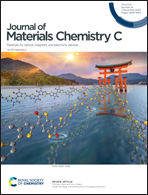Gate-tunable two-dimensional superconductivity revealed in flexible wafer-scale hybrid structures†
Abstract
Superconducting devices such as superconducting quantum interference devices, superconductor nanowire single photon detectors, and superconducting quantum chips have unique performances not available in conventional semiconductor devices. However, most of the superconducting devices are fabricated on rigid substrates consequently limiting applications requiring mechanical flexibility. Herein, wafer-scale flexible superconducting devices are designed and constructed based on a two-dimensional (2D) superconducting system consisting of superconducting discrete Pb nano-islands and single-crystalline graphene on a stretchable parylene C substrate. Owing to the perfect two-dimensional electron gas (2DEG) provided by single-crystalline graphene, the discrete Pb nano-islands are coupled to form a global zero-resistance superconducting state in the hybrid system. Since the discrete island structure is integrated with flexible graphene and parylene C, the superconducting device works steadily even in the bent state. In addition, the Berezinskii–Kosterlitz–Thouless (BKT) type phase transition, the hallmark of two-dimensional superconductivity, can be tuned by the back-gate bias. Our results suggest a convenient and effective strategy to design and prepare large-scale and flexible superconducting systems.



 Please wait while we load your content...
Please wait while we load your content...